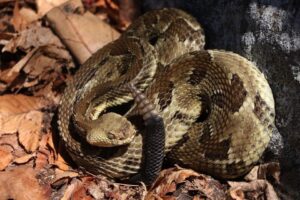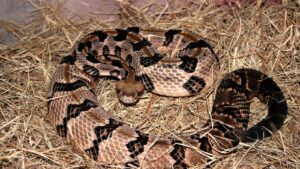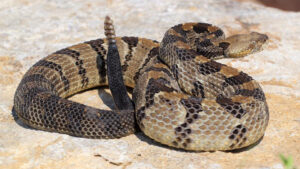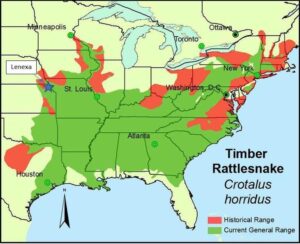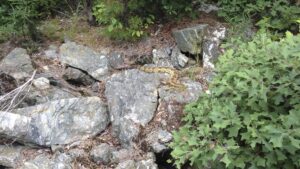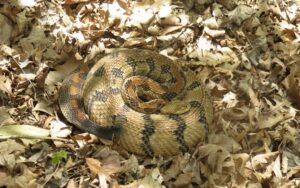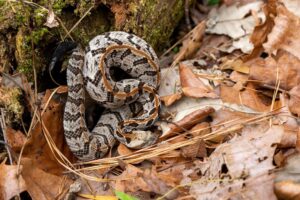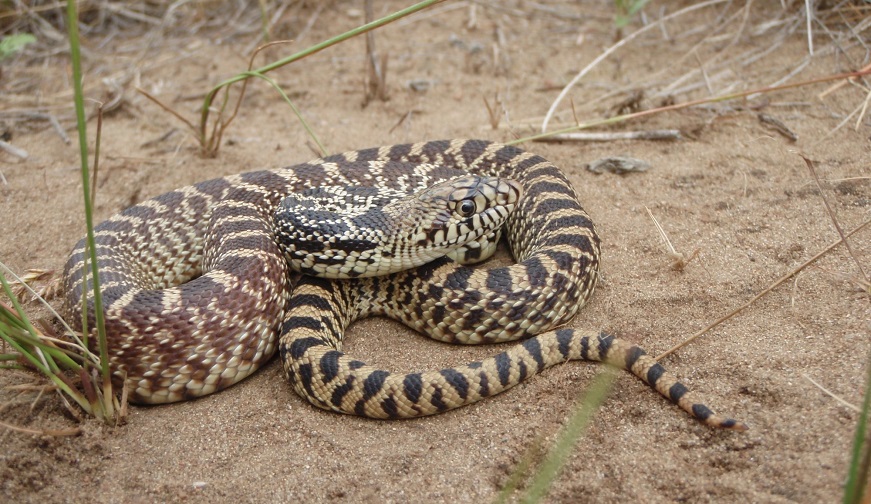The timber rattlesnake is a large, heavy-bodied pit viper species native to eastern North America. It is also known by the names canebrake rattlesnake and banded rattlesnake. It was recognized as the state reptile of West Virginia in 2008. It is a very poisonous snake with a deadly bite.
Scientific Classifications
- Suborder:Serpentes
- Family:Viperidae
- Genus:Crotalus
- Species:C. horridus
Conservation Status
Description
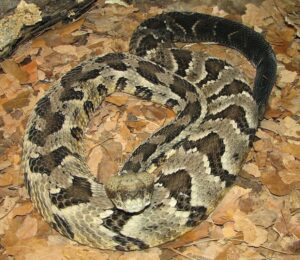
Size
The adults can get as big as 36-60 in (91-152 cm) in length, including the tail. Most of them measure 45 in (115 cm) in total length and weigh 1.1-3.3 lb (500-1500g). The largest recorded total length is 74.5 in (189.2 cm). The bigger specimens can weigh as much as 9.9 lb (4.5 kg). The smallest size female in Pennsylvania that could produce viable eggs was 28.4 in (72.2 cm). The species exhibits sexual dimorphism, with the males being larger than the females.
Color and Appearance
The keeled dorsal scales are arranged in 21-26 scale rows at the midbody (usually 23 rows in the northern part of its range and 25 rows in the southern part). There are 158-177 ventral scales in males and 163-183 in females. The number of subcaudal scales is 2-30 in males and 15-26 in females. The rostral scale usually has a slightly greater height than its width.
The dorsal pattern of black or dark brown crossbands is set against a grayish or yellowish-brown background. The M- or V-shaped crossbands have irregular zig-zag edges. A rust-colored vertebral stripe is often present. Ventrally they can be uniform yellowish or marked with black. Melanism is common in the species.
The big and thick head, distinct from the neck, sometimes has a dark diagonal line just behind or through the eye.
Are They Dangerous to Humans
The venomous snake has a very dangerous bite with venom potent enough to kill a human. In fact, it is one of North America’s most dangerous snakes due to its impressive size, long fangs, and high venom yield. But it is somewhat offset by its long brumation period and mild disposition. Before striking, it gives a lot of warnings in the form of rattling and feinting. When threatened, the canebrake rattlesnake props itself up and shakes its rattle producing a crisp and rapid rattling sound. The canebrake rattlesnake is not aggressive and bites in defense, only as a last resort.
The rate of envenomation is 40-60%. In the case of a bite, the survival rate is 90-99% (with timely treatment), as the rate of envenomation is 40-60%. Nevertheless, the bite of the timber rattlesnake is a medical emergency.
The venom can be predominantly neurotoxic or hemorrhagic and proteolytic. The hemotoxins in the venom prevent blood coagulation, reducing platelet numbers. Severe cases can lead to internal bleeding and hemorrhaging. It can also cause necrosis or cell death making the skin around the bite appear black. The neurotoxins in the venom affect the nervous system, leading to paralysis, muscle spasms, cardiac arrest, and breathing difficulty. The CroFab antivenom is used to treat its envenomations.
Timber Rattlesnakes at a Glance
Distribution
In the eastern United States, it ranges from southern New Hampshire and southern Minnesota, south to North Florida and East Texas. Historically, they were also found in Maine, Rhode Island and southern Canada. But the species is extirpated in Canada and threatened in several US states. Though many Appalachian US states protect the snake by law, its population is on the decline.
It was historically abundant all over New England but there has been a recent fall in the last known population in New Hampshire that is heading towards extinction due to inbreeding, genetic isolation, and unpredictable weather conditions.
Habitat
This species generally lives in deciduous hardwood forests in rugged terrain. They are also found in wetlands, lowlands, or residential areas near dens. The excellent climber has been found in trees more than 80 ft high.
During summer, gravid females prefer staying in open, rocky ledges with higher temperatures. On the other hand, the non-gravid females and males like to live in denser, cooler, woodlands with more closed forest canopies. In winter, the species brumates in limestone crevices and dens, often with black rat snakes and copperheads. Though the males mate farther away from their winter hibernating sites (hibernacula) than females, the individuals of this species return to the same hibernaculum every year.
Lifespan
It can live for around 16-22 years.
Predators
Raccoons, coyotes, bobcats, skunks, foxes, owls, and hawks eat the rattlesnake. Other snakes like copperheads and kingsnakes are also its predators.
Their dwindling population can be attributed to their killing by humans out of unwarranted fear of venomous snakes and commercial hunting apart from habitat loss and fragmentation.
Diet
The rattlesnake mainly eats small mammals such as squirrels, voles, cottontail rabbits, cotton rats, etc., but can take frogs, birds (mainly ground-dwelling species like passerines and bobwhites), and other small animals, including other snakes. Though it can eat rattlesnakes, the garter snake is the most common snake consumed by it. The babies differ a little in their food preferences and are more likely to consume smaller prey like shrews. But the number one prey for both the young and the adults are deer mice.
Timber rattlesnakes use chemical cues to find locations to ambush their prey. They often strike and track their prey till they can eat them. The serpent is known to wait in fallen logs for its prey (that is almost entirely terrestrial rather than arboreal) to pass by as they give it an elevated perch to strike. It remains unfazed by the defensive displays of its prey, if any.
Reproduction
Ovoviviparous (gives birth to live young from eggs that hatch inside the body)
The mating season of the species starts in early summer and continues till early autumn. The snakes reach sexual maturity when they are around 5 years old and reproduce every 2-3 years. The females frequently bask in the sun before giving birth in open rocky areas called ‘basking knolls’. 6-12 young per clutch are born in late summer or early fall. An average of 7-8 offspring form a litter.
The juveniles measure 8-16 in (20-40 cm) in length. They are born with only the first segment of their rattle, called a ‘button’ and are lighter in color. Otherwise, they are miniature versions of the adults.
Similar Species
Eastern Diamondback
The eastern diamondback rattlesnake (Crotalus adamanteus) has a diamond pattern along its body, while the timber rattlesnake has a chevron pattern. The former also has dark, banded eyes and lacks the stripe on its back – a characteristic of the latter. The venom of the eastern diamondback has a median lethal dose of 1.2 mg/kg, while that of the canebrake is 1.64 mg/kg. So the former’s venom is more toxic than the latter’s.
Copperhead
Unlike the timber rattlesnake, the copperhead (Agkistrodon contortrix) lacks a rattle at the end of its tail. Plus, it has hourglass-like banding patterns instead of the dark chevron-shaped bands in the latter.
FAQs
Ans. Yes, timber rattlesnakes can swim on the water’s surface and below it.
Ans. Yes, timber rattlesnakes are protected in Texas, prohibiting people from collecting them without a scientific collection permit. Indiscriminate killing or any other control of the species is illegal there. In fact, it is the only venomous snake that is protected in the said state. The penalty for killing the snake could attract fines of up to $100,000 and imprisonment of one year. Equipment used for violating the law are subject to forfeiture.
Source
bostonglobe.com, npr.brightspotcdn.com, msdmanuals.com, webapps.fhsu.edu, wildlifepreservation.ca, blog.nature.org, .iowaherps.com, msherps.com, livingwithsnakes.org

